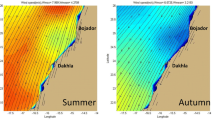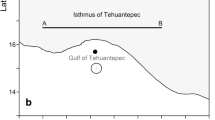Abstract
In this paper we study the seasonal and interannual variability of the morphometric characteristics of the Benguela upwelling—shape, area, and length—using satellite measurements of the ocean surface temperature (sear surface temperature (SST)) for 1985–2016. The northern part of the Benguela Upwelling (NBU) (18°–26° S) is characterized by an increase in area from January to July and a minimum in August–December. In the northernmost part of the upwelling (18°–21° S), the largest area is observed in April–August, while it takes on minimal values in January–February and October–November. These changes are associated with the intensification of the southern Angola current, which occurs in February and October, the effect of which can be traced up to 24° S. The maximum in the southern part (28–32°C) of the Benguela upwelling (SBU) is observed for 1–2 months later in May–June, and SBU practically disappears in September–November. In the autumn months, the jet of the northern current of the Agulhas presses against the coast of Africa, contributing to a sharp decrease in the SBU area. On interannual scales, there is a pronounced variability in the upwelling area and the time of its peak. In this case, there is a trend towards an earlier onset of upwelling after 2010. In the northernmost part of the studied area, high values of the upwelling width (150 km) were observed at latitudes of 19°–22° S up to 2000. Then they sharply decrease and the average width decreases almost three times to 50 km. At the same time, there was a sharp increase in the area by the same amount of ~100 km2 at latitudes 23°–28° S. Thus, there was a sharp change in the upwelling shape, while the total upwelling area remained constant. The weakening and decrease in upwelling in its northernmost part is probably caused by the long-term strengthening of the Angola current, which is observed by altimetry data.











Similar content being viewed by others
REFERENCES
Backeberg, B.C., Penven, P., and Rouault, M., Impact of intensified Indian Ocean winds on mesoscale variability in the Agulhas system, Nat. Clim. Change, 2012, vol. 2, no. 8, pp. 608–612.
Campillo-Campbell, C. and Gordoa, A., Physical and biological variability in the Namibian upwelling system: October 1997–october 2001, Deep-Sea Res., Part II, 2004, vol. 51, nos. 1–3, pp. 147–158.
Chen, Z., Yan, X.-H., Jo, Y.-H., et al., A study of Benguela upwelling system using different upwelling indices derived from remotely sensed data, Cont. Shelf Res., 2012, vol. 45, pp. 27–33.
Chernyshkov, P.P., Mesoscale variability of the thermal structure of the upper ocean layer in a test field in the Equatorial Atlantic, in Dokl. II Vsesoyuz. Konf. po izucheniyu otkrytoi chaste Atlanticheskogo okeana (Proceedings of the II All-Union Conference on the Open Part of the Atlantic), Kaliningrad: AOIOAN, 1982, pp. 56–59.
Demarcq, H., Barlow, R., and Hutchings, L., Application of a chlorophyll index derived from satellite data to investigate the variability of phytoplankton in the Benguela ecosystem, Afr. J. Mar. Sci., 2007, vol. 29, no. 2, pp. 271–282.
Hagen E., Feistel R., Agenbag, J.J. and Ohde, T., Seasonal and interannual changes in intense Benguela upwelling, Oceanol. Acta, 2001, vol. 24, pp. 557–568.
Hardman-Mountford, N.J., Richardson, A.J., Agenbag, J.J., Hagen, E., Nykjaer, L., Shillington, F.A., and Villacastin, C., Ocean climate of the South East Atlantic observed from satellite data and wind models, Prog. Oceanogr., 2003, vol. 59, pp. 181–221.
IPCC, 2014: Climate Change 2014: Synthesis Report. Contribution of Working Groups I, II and III to the Fifth Assessment Report of the Intergovernmental Panel on Climate Change, Pachauri, R.K. and Meyer, L.A., Eds., Geneva: IPCC, 2014.
Lamont, T., García-Reyes, M., Bograd, S.J., et al., Upwelling indices for comparative ecosystem studies: Variability in the Benguela Upwelling System, J. Mar. Syst., 2018, vol. 188, pp. 3–16.
Lomakin, P.D., Upwelling in the Kerch Strait and the adjacent waters of the Black Sea based on the contact and satellite data, Phys. Oceanogr., 2018, vol. 25, no. 2, pp. 114–123.
Lutz, K., Jacobeit, J., and Rathmann, J., Atlantic warm and cold-water events and impact on African west coast precipitation. Int. J. Climatol., 2015, vol. 35, no. 1, pp. 128–141.
Nixon, S. and Thomas, A., On the size of the Peru upwelling ecosystem, Deep-Sea Res., Part I, 2001, vol. 48, no. 11, pp. 2521–2528.
Polonskii, A.B. and Serebrennikov, A.N., On the change in the ocean surface temperature in the Benguela upwelling region. Part 1: Season cycle, Izv., Atmos. Ocean. Phys., 2019, vol. 55, no. 9, pp. 1150–1159.
Polonskii, A.B. and Serebrennikov, A.N., On the change in the sea surface temperature in the Benguela upwelling region. Part 2: Long-term tendencies, Izv., Atmos. Ocean. Phys., 2020, vol. 56, no. 9, pp. 970–978.
Reynolds, R.W., et al., Daily high-resolution-blended analyses for sea surface temperature, J. Clim., 2007, vol. 20, no. 22, pp. 5473–5496.
Rouault, M., Florenchie, P., Fauchereau, N., and Reason, C.J.C., South East tropical Atlantic warm events and southern African rainfall, Geophys. Res. Lett., 2003, vol. 30, no. 5.
Strub, P.T., Shillington, F.A., James, C., and Weeks, S., Satellite comparison of the seasonal circulation in the Benguela and California current systems, South Afr. J. Mar. Sci., 1998, vol. 19, pp. 99–112.
im, N., Zorita, E., and Hünicke, B., Decadal variability and trends of the Benguela upwelling system as simulated in a high-resolution ocean simulation, Ocean Sci., 2015, vol. 11, pp. 483–502
Veitch, J.A. and Penven, P., The role of the Agulhas in the Benguela current system: A numerical modeling approach, J. Geophys. Res.: Oceans, 2017, vol. 122, no. 4, pp. 3375–3393.
Vizy, E.K. and Cook, K.H., Mesoscale convective systems and nocturnal rainfall over the West African Sahel: Role of the inter-tropical front, Clim. Dyn., 2018, vol. 50, nos. 1–2, pp. 587–614.
Funding
The study of the variability of upwelling morphometric characteristics was supported by the Russian Science Foundation. Upwelling SST research was supported by State Task no. 0555-2021-0006.
Author information
Authors and Affiliations
Corresponding author
Ethics declarations
The authors declare that they have no conflicts of interest.
Additional information
Translated by A. Ivanov
Rights and permissions
About this article
Cite this article
Pavlushin, V.A., Kubryakov, A.A. Variability of the Area and Shape of the Benguela Upwelling in 1985–2017 and Its Relation with Dynamic Characteristics from Satellite Measurements. Izv. Atmos. Ocean. Phys. 58, 1037–1048 (2022). https://doi.org/10.1134/S000143382209016X
Received:
Published:
Issue Date:
DOI: https://doi.org/10.1134/S000143382209016X




